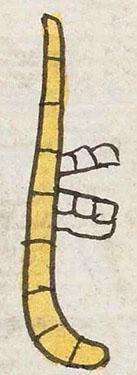Otlatitlan (Mdz46r)
This compound glyph for the place name Otlatitlan includes two prominent visual components. One is the stalk of bamboo or cane called otlatl). A full set of teeth, with jaw, protrude from the stalk, in profile, facing to the viewer's left. These teeth do not have a semantic value, they provide the phonetic element for the locative suffix (-tlan) (near, telling where).
Stephanie Wood
Gordon Whittaker (Deciphering Aztec Hieroglyphs, 2021, 102) has discovered that the somewhat often a full set of teeth (top and bottom) are used, as here, when there is a ligature (-ti-) implied before the locative suffix -tlan.
Stephanie Wood
otla titlan/puo
Otlatitlan, pueblo
Stephanie Wood
c. 1541, but by 1553 at the latest
Stephanie Wood
bamboo, cane, reeds, teeth, bambú, caña, carrizo, dientes, nombres de lugares

otla(tl), bamboo, https://nahuatl.wired-humanities.org/content/otlatl
-tlan (locative suffix), by or among (a place), https://nahuatl.wired-humanities.org/content/tlan
"Among the Bamboo" (Whittaker, 2021, 102); "Among Much Bamboo" (Berdan and Anawalt, 1992, 196)
OTLA-titlan
Codex Mendoza, folio 46 recto, https://digital.bodleian.ox.ac.uk/objects/2fea788e-2aa2-4f08-b6d9-648c00..., image 102 of 188.
The Bodleian Libraries, University of Oxford, hold the original manuscript, the MS. Arch. Selden. A. 1. This image is published here under the UK Creative Commons, “Attribution-NonCommercial-ShareAlike 3.0 License” (CC-BY-NC-SA 3.0).


